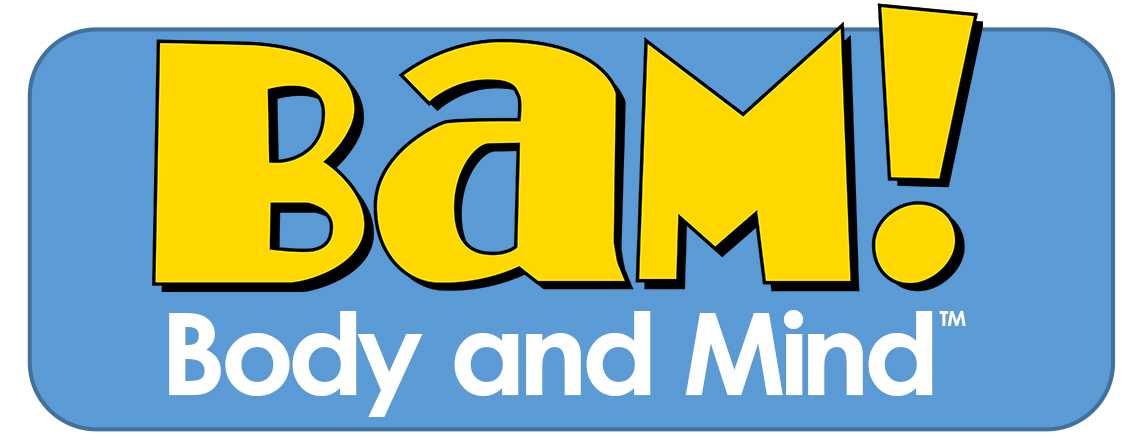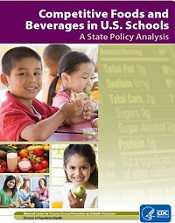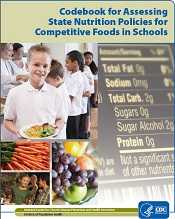Smart Snacks
Smart Snacks
 What are Smart Snacks in School?
What are Smart Snacks in School?
Smart Snacks in School refers to the national nutrition standards for foods and beverages sold outside of the federal reimbursable school meal programs during the school day. These items called “competitive foods” because they can compete with participation in school meal programs.
As of the 2014–2015 school year, all competitive foods and beverages sold during the school day must meet or exceed Smart Snacks in School nutrition standards, which include limits on fat, sugar, sodium, and calorie content. These standards are the minimum requirement for schools, but states and local education agencies can continue to implement stronger nutrition standards for all competitive foods in schools.
Institute of Medicine Report: Nutrition Standards for Foods in Schools
To provide schools with guidance on improving the foods and beverages offered to students, CDC conducted a study with the Institute of Medicine (IOM) to review the science and make recommendations about nutrition standards for foods and beverages offered in direct competition with school-provided meals and snacks. The study resulted in a report entitled, Nutrition Standards for Foods in Schools: Leading the Way toward Healthier Youth. The IOM recommendations serve as the gold standard for the availability and content of competitive foods in schools.
Competitive Foods and Beverages in US Schools: A State Policy Analysis
To determine how closely state competitive food policies align with the IOM’s Nutrition Standards for Foods in Schools, CDC conducted an analysis of state laws and policies (as of October 1, 2010) that regulate the availability and content of competitive foods in schools. A codebook was developed by CDC researchers to guide the coding and analysis of state policies. As of October 2010, 39 states had adopted policies for competitive foods in schools, but the content of these policies varied by state and grade level.
What You Can Do
Fact Sheets
CDC developed a set of four audience-specific fact sheets as a resource for school staff, parents, and young people to use to support and develop strong nutrition standards that can affect the health of students at school. These fact sheets are designed to answer commonly asked questions about the IOM’s Nutrition Standards for Foods in Schools report and provide recommendations for implementing the standards.
- For Parents, Guardians, Teachers, and School Staff [PDF – 1.5 MB]
- For School Boards, School Districts, and Other School Administrators [PDF – 482 KB]
- For School Nutrition Service Personnel [PDF – 2.6 MB]
- For Students [PDF – 826 KB]
Use CDC’s fact sheet series as a resource to help develop and support strong nutrition standards for foods and beverages in schools
- Review your school wellness policy to help ensure that the nutrition guidelines align with the IOM standards and that students have access to healthy foods such as fruits, vegetables, whole grains, and low-fat or nonfat dairy during each school day.
- Examine the actual foods and beverages that are available to students including foods and beverages sold in vending machines, school stores, snack bars, and as a’ la carte items to determine if they meet the nutrition standards.
- Educate students about nutrition by offering and promoting healthy food and beverage choices that meet the nutrition standards.
What Are Competitive Foods?
|
Competitive foods include
* State agencies that administer school meal programs have the authority to exempt an infrequent number of fundraisers from meeting these standards each year. |
Successfully Implementing Strong Nutrition Standards for Competitive Foods and Beverages: Case Studies of School Districts
To illustrate how schools and districts can implement strong nutrition standards for competitive foods without significant financial losses, CDC supported a study by the Illinois Public Health Institute (IPHI) and the University of Illinois, Chicago (UIC) to examine eight school districts across the country. IPHI published findings and case studies in the report Controlling Junk Food and the Bottom Line: Case Studies of Schools Successfully Implementing Strong Nutrition Standards for Competitive Foods and Beverages. Schools can use this resource to find examples of successful strategies used to overcome challenges and support strong nutrition standards in schools.
IPHI and CDC partnered to release five tip sheets that highlight key findings from the study and share strategies from districts that have successfully implemented healthier competitive foods standards, sold more fruits and vegetables, taught nutrition to students, and made cafeterias more enticing for students.
References (expand to view)
- Fox MK, Gordon A, Nogales R, Wilson A. Availability and consumption of competitive foods in US public schools. Journal of the American Dietetic Association 2009;109:S57–S66.
- Government Accountability Office. School Meal Programs: Competitive Foods Are Widely Available and Generate Substantial Revenues for Schools. Washington, DC: Government Accountability Office;2005. GAO Publication no. GAO-05-563.
- National School Lunch Program, Competitive Food Services, 7 C.F.R. Sect. 210.11 (2012).
- School Breakfast Program, Competitive Food Services, 7 C.F.R. Sect. 220.12 (2012).
- Page last reviewed: May 16, 2017
- Page last updated: May 16, 2017
- Content source:



 ShareCompartir
ShareCompartir


